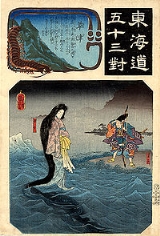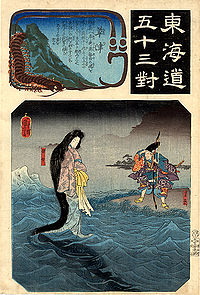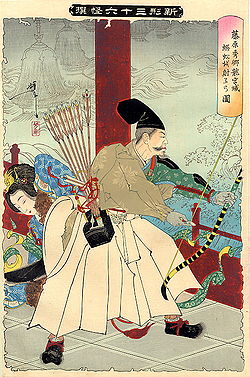
My Lord Bag of Rice
Encyclopedia


Fairy tale
A fairy tale is a type of short story that typically features such folkloric characters, such as fairies, goblins, elves, trolls, dwarves, giants or gnomes, and usually magic or enchantments. However, only a small number of the stories refer to fairies...
about a hero who kills the giant centipede Seta to help a Japanese dragon
Japanese dragon
Japanese dragons are diverse legendary creatures in Japanese mythology and folklore. Japanese dragon myths amalgamate native legends with imported stories about dragons from China, Korea and India. The style of the dragon was heavily influenced by the Chinese dragon...
princess, and is rewarded in her underwater Ryūgū-jō
Ryugu-jo
In Japanese mythology, Ryūgū-jō is the undersea palace of Ryūjin, the dragon god of the sea. Depending on the version of the legend, it is built from red and white coral, or from solid crystal. The inhabitants of the palace were Ryūjin's servants, which were various denizens of the sea...
龍宮城 "dragon palace castle".
The 1711 Honchō kwaidan koji 本朝怪談故事 contains the best-known version of this Japanese myth
Japanese mythology
Japanese mythology is a system of beliefs that embraces Shinto and Buddhist traditions as well as agriculturally based folk religion. The Shinto pantheon comprises innumerable kami...
about the warrior Fujiwara no Hidesato
Fujiwara no Hidesato
was a kuge of tenth century Heian Japan. He is famous for his military exploits and courage, and is regarded the common ancestor of the Ōshū branch of the Fujiwara clan, the Yūki, Oyama, and Shimokōbe families....
. There is a Shinto shrine near the Seta Bridge at Lake Biwa
Lake Biwa
is the largest freshwater lake in Japan, located in Shiga Prefecture , northeast of the former capital city of Kyoto. Because of its proximity to the ancient capital, references to Lake Biwa appear frequently in Japanese literature, particularly in poetry and in historical accounts of battles.-...
where people worship Tawara Tōda 俵藤太 "Rice-bag Tōda" (a pun between tawara "straw rice-bag; straw barrel" and the Japanese name
Japanese name
in modern times usually consist of a family name , followed by a given name. "Middle names" are not generally used.Japanese names are usually written in kanji, which are characters of usually Chinese origin in Japanese pronunciation...
Tawara 田原).
In olden times, when Fujiwara no Hidesato (who lived in the first half of the tenth century) crossed the bridge, a big serpent lay across it. The hero, however, was not at all afraid, and calmly stepped over the monster which at once disappeared into the water and returned in the shape of a beautiful woman. Two thousand years, she said, she had lived under this bridge, but never had she seen such a brave man as he. For this reason she requested him to destroy her enemy, a huge centipede, which had killed her sons and grandsons. Hidesato promised her to do so and, armed with a bow and arrows, awaited the centipede on the bridge. There came from the top of Mt. Mikami two enormous lights, as big as the light of two hundred torches. These were the centipede's eyes, and Hidesato sent three arrows in that direction, whereupon the lights were extinguished and the monster died. The dragon woman, filled with joy and gratitude, took the hero with her to the splendid Dragon-palace, where she regaled him with delicious dishes and rewarded him with a piece of silk, a sword, an armour, a temple bell and a bag (tawara) of rice. She said, that there would always be silk left as long as he lived, however much he might cut from it; and the bag of rice would never be empty.
Hidesato subsequently donated this bell to Mii-dera
Mii-dera
', formally called ', is a Buddhist temple located at the foot of Mount Hiei, in the city of Ōtsu, in Shiga Prefecture. It is only a short distance from both Kyoto, and Lake Biwa, Japan's largest lake. The head temple of the Tendai Jimon sect, it is something of a sister temple to Enryakuji, at...
temple at Mount Hiei
Mount Hiei
is a mountain to the northeast of Kyoto, lying on the border between the Kyoto and Shiga prefectures, Japan.The temple of Enryaku-ji, the first outpost of the Japanese Tiantai sect of Buddhism, was founded atop Mount Hiei by Saichō in 788. Both Nichiren and Honen studied at the temple before...
but it was stolen by a priest from rival Enryaku-ji
Enryaku-ji
thumb|300px|Konpon Chū-dō , Enryaku-ji's main hall is a Tendai monastery located on Mount Hiei in Ōtsu, overlooking Kyoto. It was founded during the early Heian period. The temple complex was established by Saichō , also known as Dengyō Daishi, who introduced the Tendai sect of Mahayana Buddhism...
temple. He threw it into a valley after it spoke to him, and when the cracked bell was returned to Mii-dera, a small snake (the dragon) used its tail to repair the damage. The 14th-century Taiheiki
Taiheiki
The is a Japanese historical epic , written in the late 14th century. It deals primarily with the Nanboku-chō, the period of war between the Northern Court of Ashikaga Takauji in Kyoto, and the Southern Court of Emperor Go-Daigo in Yoshino....
records an earlier version of this legend about Hidesato, set during the Genpei War
Genpei War
The was a conflict between the Taira and Minamoto clans during the late-Heian period of Japan. It resulted in the fall of the Taira clan and the establishment of the Kamakura shogunate under Minamoto Yoritomo in 1192....
, but instead of the dragon turning into a beautiful woman, it transforms into a "strange small man" – the Dragon King
Dragon King
The four Dragon Kings are, in Chinese mythology, the divine rulers of the four seas . Although Dragon Kings appear in their true forms as dragons, they have the ability to shapeshift into human form...
himself.
This Lord Bag of Rice fable is included in Japanese Fairy Tales by Yei Theodora Ozaki
Yei Theodora Ozaki
Yei Theodora Ozaki was an early 20th century translator of Japanese short stories and fairy tales. Her translations were fairly liberal but have been popular, and were reprinted several times after her death.According to "A Biographical Sketch" by Mrs...
and A Book of Dragons
A Book of Dragons
A Book of Dragons is a 1965 anthology of 14 fairy tales from around the world that have been collected and retold by Ruth Manning-Sanders. It is one in a long series of such anthologies by Manning-Sanders....
by Ruth Manning-Sanders
Ruth Manning-Sanders
Ruth Manning-Sanders was a prolific British poet and author who was perhaps best known for her series of children's books in which she collected and retold fairy tales from all over the world. All told, she published more than 90 books during her lifetime. The dust jacket for A Book of Giants...
.

